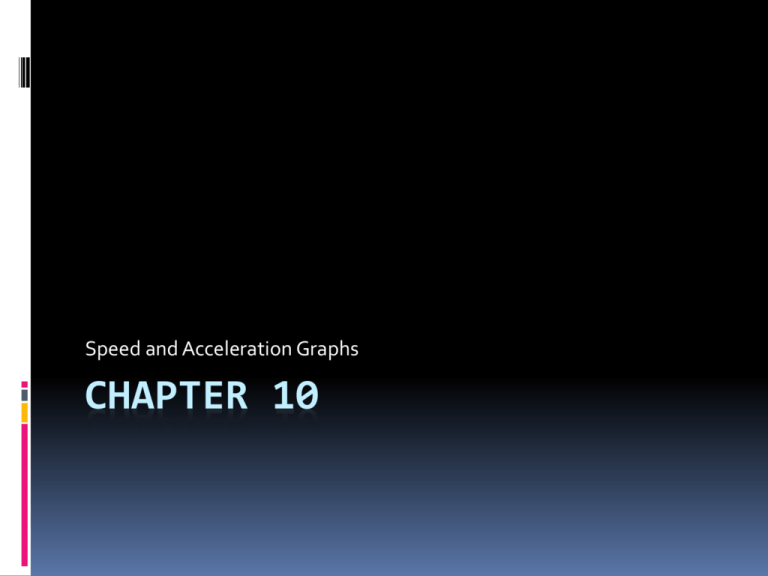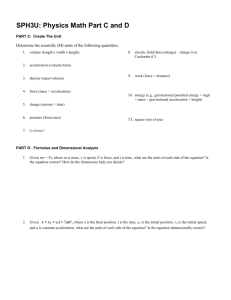CH11 Review Questions
advertisement

Speed and Acceleration Graphs CHAPTER 10 CH10 Question 1 Describe the object’s motion in the graph above. Move a at constant speed for 4 sec, slows down for 3 seconds then speeds up but not to original velocity. CH10 Question 2 Describe the object’s motion in the graph above. Move a at constant speed for 4 s, and comes to a rest. CH10 Question 3 Describe the object’s motion in the graph above. Positive acceleration for 5 seconds – speeds up. CH10 Question 4 Describe the object’s motion in the graph above. Constant speed 150s, const +accl. For 100 s. Constant speed again for 50 sec, then – accl for one sec. CH10 Question 4 Calculate the object’s acceleration from 150 to 250 seconds. Vf-Vi/t = 30-10/100= 0,2 m/s2 CH10 Question 4 Calculate the object’s acceleration from 300 to 350 seconds. Vf-Vi/t = 5m/s-30m/s/50 s= -0.5 m/s2 Forces and Motion CHAPTER 11 Question 1 State Newton’s First Law of motion An object at rest will remain at rest and object in motion remain in motion unless acted on by a net force. Question 2 State Newton’s Second Law of Motion An object will accelerate in the direction of a net force. Question 3 State Newton’s Third Law of Motion For every action there is an equal and opposite reaction. Question 1 What is the equation for calculating Force when you know an object’s mass and acceleration? Question 1 What is the equation for calculating Force when you know an object’s mass and acceleration? Force = mass x acceleration F = ma. Question 2 What are the units for Force? Question 2 What are the units for Force? Kg m/s2 N = Newton Question 3 A sailboat with a mass of 1000 kg is accelerating at a rate of 8 m/s2. What is the force of the wind acting on the sail? F= ma F = 1000 kg x 8 m/s2 = 8000 N Question 1 What equation do you use to calculate acceleration if you know the force acting on the object and its mass? F= ma A = F/m = F m Question 2 What are the units for acceleration? m/s2 “meters per second squared” Question 3 What is the acceleration of a 50Kg swimmer that pushes off the side of the pool with a force of 100N? a = F/m = 100 kgm/s2 50 kg = 2 m/s2 Question 1 What is the formula used to calculate mass when you know the Force on an object and the resulting acceleration? F = ma m = F/a = F a Question 2 A weight lifter accelerates the barbell at a rate of 2.0 m/s2 with an applied force 400N. What is the mass of the barbell? m = F/a = 400 kg m/s2 5 m/s2 = 80 kg Question 3 What is the relationship between mass and inertia?? As the mass increases the inertia of an object increases and a greater force will be required to accelerate the object. Question 1 What is the formula used to calculate the weight of an object on Earth? weight = mass x gravitational acceleration. Gravitational acceleration on earth = 9.8 m/s2 Question 2 What is the difference between mass and weight? Mass is a measure of how much matter an object contains. Weight is a measure of the force of gravity acting on that mass. Question 3 Calculate the weight of 10 kg of gold sitting on your desk. weight = mass x ag ag =9.8 m/s2 W = 10 kg x 9.8 m/s2 = 98 N m m 1 2 Question 1 F G 2 d Name this equation and the variables that compose it. Question 1 m1 m2 F G 2 d Name this equation and the variables that compose it. Universal Gravitation F = force of gravity G = gravitational constant m = mass of the objects D2 = distance between the objects Question 2 m1 m2 F G 2 d According to the equation what happens to the gravitational force between two objects when they get farther apart? Question 2 m1 m2 F G 2 d According to the equation what happens to the gravitational force between two objects when they get farther apart? d2 increases and the force of gravity gets smaller. Question 3 m1 m2 F G 2 d According to the equation why does our sun have a gravitational force strong enough to hold all the planets in orbit even though some are very far away. Question 3 m1 m2 F G 2 d According to the equation why does our sun have a gravitational force strong enough to hold all the planets in orbit even though some are very far away. The sun has a very large mass so its gravitational force is large and far reaching. Question 1 What is the term used to describe an object where the only force acting on the object is gravity ? Free Fall Question 2 This is the maximum velocity a falling object will reach as the upward force of air resistance equals the downward force of gravity? Terminal velocity Question 3 If an object at terminal velocity is experiencing balanced forces, how can the object still be falling? Balanced forces only mean that the object is not ACCELERATING, it still falls @ a constant velocity. Question 1 A fluid includes which three states of matter? Liquids, gases, and plasmas Question 2 What is the formula used to calculate pressure and what unit is pressure reported in? P = mass Area = N/m2 = Pa Usually kPa (kilo Pascals) Question 3 What is the air pressure if 20 N is exerted over an area of 10m2? P = mass/Area = 20N 10m2 = 2 Pa Question 1 According to Bernoulli’s Principal what happens to the pressure of a fluid as the velocity of the fluid increases? Question 1 According to Bernoulli’s Principal what happens to the pressure of a fluid as the velocity of the fluid increases? The pressure decreases. Question 2 What is the upward force exerted on an object immersed in a fluid? Buoyant force or buoyancy. Question 3 Archimedes Principal states that for an object to float the weight of the object must be equal to or less than .. . . ? Question 3 Archimedes Principal states that for an object to float the weight of the object must be equal to or less than .. . . ? the weight of the fluid displaced by the object. Question 1 What term is used to describe the resistance of of a gas or liquid to flow? Viscosity. Question 2 Hydraulic devices can increase the output force by increasing the output area. Which principal predicts this characteristic? Pascal’s Principal- the pressure of a liquid in an enclosed system is uniform throughout the system. Question 3 According to the Venturi effect, what happens to the velocity of a fluid when it is forced to flow through a smaller area?? The velocity of the fluid increases.. Question 1 What is the term for any object thrown or launched from Earth under the influence of gravity? Projectile Question 2 Describe the horizontal and vertical forces acting on the cannon ball. Question 3 Which will hit the ground first, the cannon ball dropped straight down or the one launched sideways? They both hit at the same time – horizontal motion is independent of vertical free-fall.

